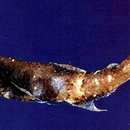Comprehensive Description
provided by Smithsonian Contributions to Zoology
Lampanyctus alatus
This is a moderately large species, growing to 61 mm (Hulley, 1981); maximum size in the Ocean Acre collections is 54 mm. Lampanyctus alatus tentatively is classified as a tropical species and is listed as one of the ranking myctophids in the North Atlantic subtropical region (Backus et al., 1977), but the Ocean Acre collections do not confirm this. The species is uncommon in the study area, and is represented in these collections by only 80 specimens; 29 were caught during the paired seasonal cruises, 13 of which were taken in discrete-depth samples, of which 10 were in noncrepuscular tows (Table 23).
DEVELOPMENTAL STAGES.—Juveniles were 21–37 mm, subadults 33–51 mm, and adults 43–51 mm SL. There was no obvious external sexual dimorphism in fish of any size. All but two adults were males. One of the females contained ova up to 0.5 mm in diameter and appeared to be ripe or nearly so. None of the large (over 40 mm) subadult females appeared to be spent.
REPRODUCTIVE CYCLE AND SEASONAL ABUNDANCE.—The reproductive status of this species in the Ocean Acre area is uncertain. Although a large ripe or nearly ripe female was taken, juveniles smaller than 18 mm were not. Individuals smaller than 30 mm SL account for less than 10 percent of the total number taken in the Ocean Acre area. This scarcity of small juveniles in the collections may indicate that recruits into the population were mostly larger fish that were spawned elsewhere. In any case, L. alatus was never very abundant in the study area (Table 81), and any spawning must be at a low level.
Fish larger than 40 mm were taken most of the year, and small fish (less than 30 mm) were taken in very low numbers in April and from July through October. These data imply a relatively long breeding season for the parent population.
VERTICAL DISTRIBUTION.—Day depths in winter (based on 3 specimens) are 701–850 m and in late summer (1 specimen) 751–800 m. Nocturnal depths in late spring (5 specimens) are 51–100 m and 251–300 m, and in late summer (1 specimen) 201–250 m (Table 81).
- bibliographic citation
- Gibbs, Robert H., Jr. and Krueger, William H. 1987. "Biology of midwater fishes of the Bermuda Ocean Acre." Smithsonian Contributions to Zoology. 1-187. https://doi.org/10.5479/si.00810282.452

